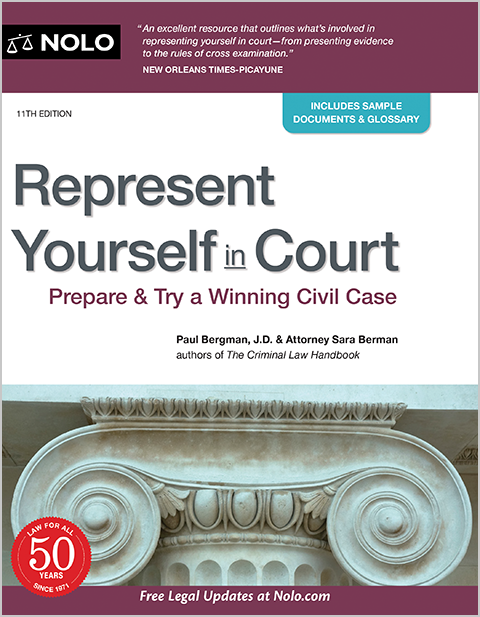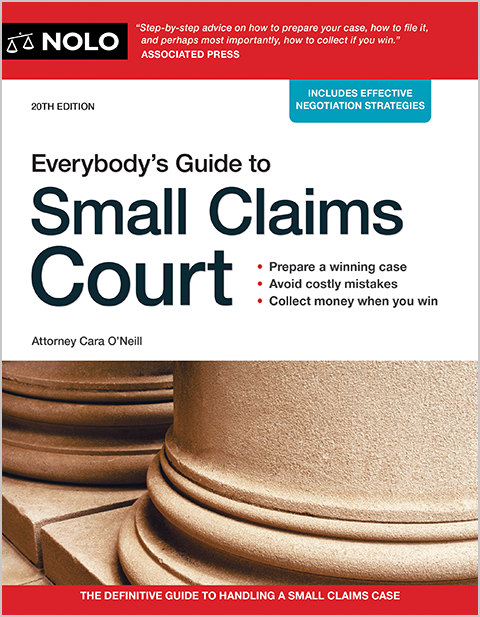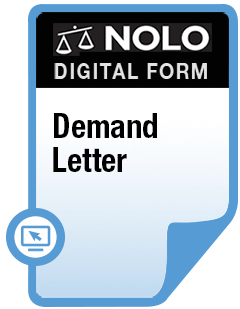Smart plaintiffs investigate before they litigate. Learn how to evaluate your chances of collecting a small claims judgment before you go to court.
Thinking about a small claims lawsuit? If so, at some point you've probably wondered: "Can I win my case?" That's a fair question. Truth be told, though, it's the wrong question.
What you really want to know is: "If I win my case, can I collect the judgment?" If the answer to that question is "yes," then you should assess your odds of winning. But if the answer is "no," think long and hard about whether it makes sense to sue. When collecting is a longshot (or worse), whether you can win is of no consequence.
We provide actionable steps you can take to size up your collection prospects, including:
- how to research the defendant's financial situation
- collection red flags—signs of likely collection problems
- making the sue—don't sue decision
- special considerations for certain defendants, and
- if you're going to sue, steps to consider before you file.
(Here are some helpful tips for collecting a judgment you've won.)
How to Research the Defendant's Financial Situation
In the simplest terms, judgment collectibility boils down to the defendant's financial situation. Before you sue, you want a snapshot of the defendant's financial condition. A defendant who has no insurance and no cash or other property you can grab is sometimes called "judgment proof."
What You're Looking For
As you research the defendant's financial situation, you're looking for assets that:
- aren't "exempt," meaning beyond the reach of creditors under state laws, and
- are worth enough to make the collection process worth your while.
State exemptions. State exemption laws shield from collection at least a portion of the value of specific assets. While each state makes its own exemptions, common examples include:
- the debtor's primary residence, called a "homestead"
- a motor vehicle
- household furniture, furnishings, kitchenware, and electronics
- clothing, school books, and musical instruments
- tools of the trade, agricultural machinery and equipment, and related supplies, and
- pensions and retirement accounts, disability payments, personal injury awards, and child support.
What's left after a sale? Finding non-exempt property is half the battle. You also need to know how much the property is worth, whether there are property or judgment liens that take priority over your claim, and how much it will cost to sell the property. Admittedly, doing this exercise ahead of a lawsuit involves some educated guessing. If you're not sure, an experienced collections lawyer can help.
Here's a quick example to illustrate the calculation. Jeff lives in a state that exempts up to $50,000 in equity in his primary residence. The home has a fair market value of $250,000 and is subject to a mortgage of $175,000. A small claims judgment creditor seizes Jeff's home and sells it at fair market value to pay a judgment of $12,000. The expenses of the sale are $15,000. How will the proceeds be paid?
First, all sale-related expenses get paid. After those costs, the first $175,000 goes to the mortgage lender. Jeff gets the next $50,000 to satisfy his homestead exemption. The remaining balance of $10,000 ($250,000 sales price - $15,000 sale expenses - $175,000 primary mortgage - $50,000 homestead exemption) will be paid to Jeff's judgment creditor.
Searching for Assets in Public Records
If you know where to look, searching public records can be a quick way to find the defendant's property. In today's online world, much if not all of this legwork can be done on the internet. Here are some good places to look.
- Real estate records. Search for real estate in every county where the defendant lives, works or has a place of business, or has relatives with whom they might jointly own property. Check for listings with the county assessor, the register of deeds, or the county recorder.
- Business records and filings. You're after records showing that the defendant owns a business or has formed a corporation, a limited liability company (LLC), or a similar business entity. The starting point will be the secretary of state's office. From there, check with the county tax assessor's office for tax registrations and maybe occupational licenses. City and municipal offices sometimes have business or occupational license information, too.
- Motor vehicle registrations. Find out about the defendant's motor vehicles by searching the county tax assessor's or secretary of state's records. In some states, commercial vehicles are registered with the state's department of transportation.
- UCC filings. Finally, check the secretary of state's office for UCC filings. When the defendant has financed business equipment or trade fixtures, the seller will file a UCC financing statement (on Form UCC-1) to record their lien against the property. The UCC-1 will tell you what kind of property was financed.
Online Investigation
We live in a world where the news cycle is 24/7, and where social and business networking are commonplace. You can use these resources to find out about the defendant's:
- Lifestyle. People like to talk on social media about where they live, their home (or vacation or investment properties), autos, RVs, boats, antiques and other collections, hobbies, where they vacation, places they shop and visit, and much more.
- Business relationships and contacts. Sites like LinkedIn can be a rich source of information about employment, work history, earnings, business ownership, professional licenses and memberships, and working relationships.
- Newsworthy activities. Online newspapers, magazines, blogs, and similar sites might report on newsworthy activities in which the defendant has been involved. There's no telling what you might find with a well-phrased Google search.
When Should You Consider a Professional Asset Search?
You've checked online and in public records, but have mostly come up empty handed. Does it make sense to hire a professional asset search service?
It depends on how much your judgment is worth. Personalized, comprehensive, and in-depth asset searches don't come cheap—you can expect to pay hundreds or thousands of dollars. You might get useful information, like places where the defendant has deposit accounts, but you'll need to decide whether the cost is worth it.
Collection Red Flags: Signs of Likely Collection Problems
As you research the defendant's financial condition, be on the lookout for collection red flags—signs you're dealing with a judgment-proof debtor. One or more of these red flags should, at the very least, make you think twice about filing suit.
Individual Defendants
When you're dealing with a judgment-proof individual, these are common signs of financial distress:
- no or only sporadic employment in low-paying, unskilled jobs, meaning you'll find it difficult to garnish wages
- a history of prior unpaid judgments or judgment liens, signaling that the defendant isn't likely to pay if you win, and that you're likely to find yourself at the end of a long line of unhappy judgment creditors
- ownership of mostly exempt property, meaning you won't have much (if any) luck seizing it and turning it into cash
- regular and repeated moves from one residence to another, indicating they can't afford basics like housing, and
- a history of bankruptcy or insolvency.
Business Defendants
Insolvent business defendants often have telltale characteristics, too. Watch out for:
- operations that take place through "shell" companies, meaning companies that are formed with no or very few assets, run for a brief period, then become dormant or disappear
- a history of complaints online or to the local Better Business Bureau, reporting poor quality work, failure to do work, and collecting money for work not properly done
- inactive business registrations
- no permanent address, or a history of moving from one location to another, and
- pending lawsuits and collection actions, as well as unpaid judgments and judgment liens.
Making the Sue—Don't Sue Decision
In the best of all worlds, your research will yield a clear decision one way or the other. Either the defendant is obviously judgment proof—meaning a lawsuit is probably a bad idea—or you don't uncover any signs of collection problems and have a green light to file. Unfortunately, the decision won't often be so cut-and-dried.
Most times, the decision making process will be more nuanced. That process should take into consideration:
- a dollars-and-cents cost-benefit analysis
- negotiating your way to a resolution instead of immediately filing a lawsuit, and
- taking a wait-and-see approach when short-term collection seems doubtful.
Do a Cost-Benefit Analysis
A cost-benefit analysis can be quite complex and involved, but a simpler calculation will do for a small claims case. This process involves some speculation, but do your best to come up with realistic estimates. Here are the steps.
- Estimate your chances of collection. Estimate a realistic percentage chance that you can collect a judgment. Imagine, for instance, that the defendant has one outstanding unpaid judgment. You might decide that this factor reduces your chances of collection by 30%. In other words, you estimate a 70% likelihood of getting some or all of your money.
- Multiply by the value of your judgment. Next, multiply the value of your expected judgment by your odds of success. For example, if you think you can win a judgment of $10,000, you'd multiply that by 70%. You have a net collectible judgment of $7,000.
- Estimate your total collection costs. Ideally, you've created a collection budget to arrive at what you're willing to spend. Say you expect to pay $150 for an online background check and $550 for a professional asset search. You estimate that post-judgment collection efforts will cost another $1,500 (consider getting help from an experienced collections lawyer to estimate these amounts). In total, your anticipated collection costs come to $2,200.
- Subtract the costs from your judgment. Finally, deduct from your net collectible judgment the total collection costs: $7,000 - $2,200 = $4,800.
Are you able (and willing) to spend $2,200 to recover $4,800? If so, it makes sense to move forward with a lawsuit. The higher the costs and the lower your recovery, the more your decision shades toward the "don't sue" side of the ledger.
Negotiate Your Way to a Settlement
When the numbers present a closer call or put you "upside down" in the judgment—meaning it will cost you more to collect than what your judgment likely is worth—filing a lawsuit probably isn't a wise choice. In that case, think about whether you might be able to negotiate your way to a satisfactory outcome.
If you think a $10,000 judgment in your favor is likely, what about offering the defendant a discount for doubts about collectability? If you can settle for $7,000 without going to court or hassling with collections, that's a good outcome. Or maybe you offer to let the defendant pay a settlement in monthly installments, together with interest. When the defendant can't afford full payment in one lump sum, a payout over time might get you over the finish line.
Sit Tight and Wait
If the cost-benefit numbers don't work out in your favor and you're doubtful of a negotiated resolution, your best bet might be to just sit tight and wait. Maybe the defendant's financial fortunes will change down the road, making it more likely you can recover.
Be sure to keep an eye on the statute of limitations for your claim. That's a deadline on your time to file a lawsuit in court. Miss it and you lose your chance to sue. Should that happen, you're not likely to negotiate a settlement, either. Absent the threat of a lawsuit, the defendant has no reason to make a deal with you.
Special Considerations for Certain Kinds of Defendants
As you investigate your collection prospects and make a budget, be aware that some kinds of defendants will pose different or additional collection challenges. In particular, pay special attention to:
- business structures—like corporations and LLCs—that are meant to shield an individual's assets from creditors
- special rules and procedures for collecting from the government, and
- issues involving out-of-state defendants.
Business Structures That Shield Assets From Creditors
When you're considering a case against an individual defendant, be on the lookout for corporations and LLCs they've created to put their assets beyond your reach. Except in unusual circumstances, you're not allowed to reach inside a corporation or an LLC to collect a debt owed by the business's owner. The law calls this "piercing the corporate veil," and it almost never works.
If you can prove that the defendant fraudulently transferred assets to a business in order to frustrate creditors like you, a court might undo the transfer. But that's no easy task. If you want to explore that option, you'll need advice from legal counsel.
Collecting From the Government
Is your potential small claims case against a state or local government? If so, the question isn't whether you can collect, but how you collect. Your pre-lawsuit research should look at what kinds of special rules and procedures you'll have to follow after you win a judgment. Check for these, among others:
- a requirement that you give notice (often within a specific time period) of your intent to collect
- the need to prepare and file a declaration, under penalties of perjury, describing the specifics of your judgment, and
- rules that bar you from using collection methods (like liens and writs of execution) you're allowed to use against individuals and businesses.
Collection Issues Involving Out-of-State Defendants
You're thinking about filing a small claims lawsuit in State A against a person or business from State B. What special collection hoops will you need to jump through? While there might be several, the most important is a requirement that you must register or "domesticate" your State A judgment in State B before you can collect there.
Domesticating a foreign judgment isn't difficult, but you'll need to follow the rules of the domesticating state. Typically, the process involves filing a certified copy of your judgment, together with an affidavit, with the trial court clerk in the county where you want to domesticate your foreign judgment.
You'll also need to send the defendant a copy of the judgment, your affidavit, and any written notice the rules require. Once the process is complete, you're free to start collection efforts, following the laws of that state.
Steps to Consider Before You File a Lawsuit
So, you've done your homework and decided there's a good chance you can collect a small claims judgment if you win. What additional steps might you consider taking either before you file a lawsuit, or as part of your lawsuit filing? Here are a couple of suggestions.
- carefully document the defendant's financial condition, and
- consider pre-judgment attachments if you're worried that the defendant might try to hide assets.
Document the Defendant's Financial Condition
As you research the defendant's financial affairs, be sure to keep detailed records of what you find, where you find it, and when you find it. Why is this important?
The idea is to create a snapshot of the defendant's financial condition. This record will come in handy at collection time, especially if the defendant has taken steps to move or hide assets. By using your documentation to show what the defendant had pre-lawsuit, you'll force them to trace the assets and show that they didn't make fraudulent transfers solely to defeat creditors.
Consider Pre-Judgment Attachments
Suppose your pre-filing investigation shows the defendant has a history of playing hide-and-seek with property and assets. Is there a way to keep them from impairing your collection options? Possibly so. Consider asking the court to "attach" (basically, put a lien on) specific assets belonging to the defendant even before you win a judgment.
The law calls this a "prejudgment attachment." It's very hard to get one, and you'll probably want a lawyer to handle the process. State and local rules will tell you what you need to prove, but it commonly involves showing that:
- you've filed or are filing a lawsuit with valid legal claims, like breach of contract or a business-related dispute
- the defendant has non-exempt assets you can attach, where they can be found, and whether others have valid claims against them
- there's a substantial likelihood your case will succeed on the merits, and
- because there's a significant risk the defendant will try to hide property, a pre-judgment attachment is necessary.
Next Steps
Chances are you're new to all of this. Doing financial investigations often requires knowledge and expertise most people simply don't have. You're likely to uncover some useful information, but you can expect to run into lots of dead ends, too. It can be a frustrating experience.
Depending on the size of your claim, it might make sense to simply hand the process off to someone who's "been there, done that." An experienced collections lawyer knows what to look for, where to look, and how to use available court processes to your advantage. Even if you want to do most of the legwork on your own, it's probably a good idea to have counsel outline the steps you should take. They can also act as a go-to resource when you run into problems or roadblocks.
Make room in your collection budget for professional help. In the long run, that help will optimize your chances of a cost-efficient and successful collection.



